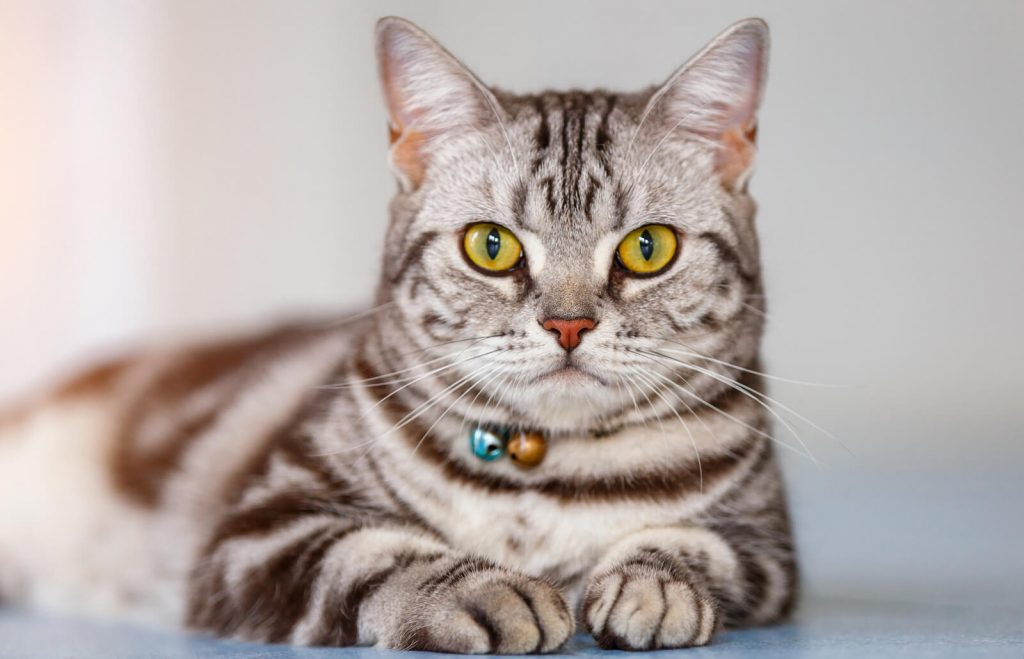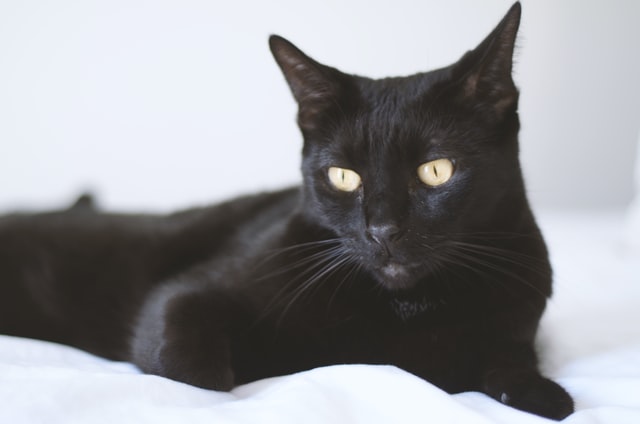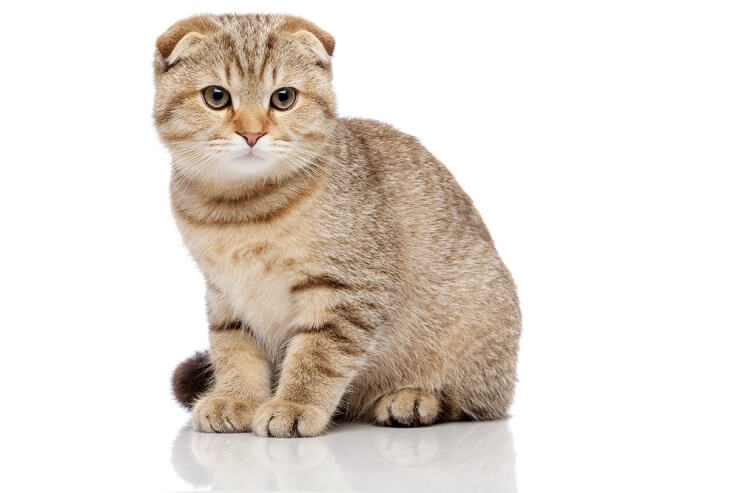The 10 Largest Domestic Cat Breeds
This page contains affiliate links. We may earn money or products from the companies mentioned in this post through our independently chosen links, which earn us a commission.
While dogs clearly come in small, medium and large sized packages, cats can vary by size and some can get quite large. Large domestic cats may appear significantly different when compared to each other, and come with their own unique traits and personalities that are considered signatures of their breed.
To help you in your search for a gentle giant we have compiled important information about the origins, size and personality of 10 large domestic cat breeds.
10 Largest Cat Breeds In The World
#1 American Bobtail Cat

- Adult Weight: 7-16 pounds
- Height: 10-16 inches
- Lifespan: 12-15 Years
- Physical Characteristics: May come in any color or pattern; shaggy, long or short coat; stubby, bobbed tail
Until recently the American Bobtail received little attention, and many people were surprised to learn that this breed has been in North America since the 1960s. The American Bobtail is just now beginning to come into their own. The new and improved American Bobtail comes in all colors, categories, and have a sweet deposition but the feral look of the bobcat.
The original Bobtail was a short-tailed brown tabby male named Yodie. He was found at an Arizona motel, supposedly dropped off by a child from a nearby reservation.
A couple found Yodie while they were vacationing at the motel. Yodie’s parents and ancestry were unknown, but rumor had it he was a bobcat and domestic cat hybrid because of his feral appearance and short, bobcat-like tail. While it’s possible for domestic cats to reproduce with bobcats, such hybrids, particularly the first generation males, would almost certainly be sterile. It’s more likely that Yodie’s bob tail occurred as a spontaneous mutation within the domestic cat population.
The Bobtail cat possess a natural hunting gaze that combined with their body type, gives them a distinctive wild appearance but they do not have a wild temperament. This breed has a devoted, loving, and intelligent personality which has earned them a loyal following. This friendly cat bonds emotionally with owners and are devoted companions that adapt quickly to most home environments.
The American Bobtail has been accepted by four North American associations.
#2 Maine Coon
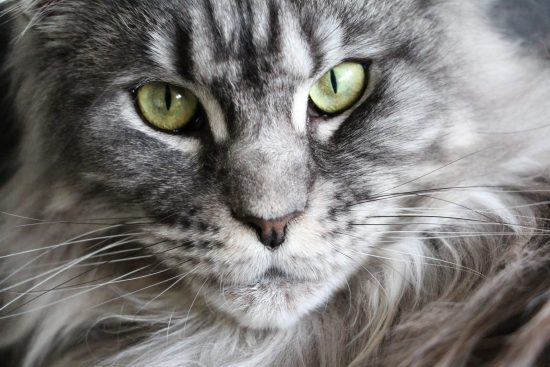
- Adult Weight: 11-25 pounds
- Height: 10-16 inches
- Lifespan: 13-16 years
- Physical Characteristics: Has large, round paws; long, smooth fur; long tail; comes in brown, black, red or white colors sometimes with tabby or tortoiseshell patterns
Maine Coon cats are considered native to America because they have been on this continent since the colonial days or even longer. Little is known about how they got here in the first place and where their progenitors came from.
Many fantastical stories exist about the origin of this breed and one story alleges that the breed is a raccoon and domestic cat hybrid, hence the name Maine Coon. This union is biologically impossible. Another unlikely but at least possible story claims that the Maine Coon was produced by bobcat and domestic cat trysts, which would explain the ear and toe tufts and the impressive size of the breed.
Another imaginative story claims that Maine Coons are descendants of longhaired cats belonging to Marie Antoinette. The Queen’s cats and other belongings were smuggled to America by a captain named Clough, who was preparing to rescue the Queen from death.
Unfortunately, the Queen lost her head, and the cats ended up staying with Clough in Maine. Last, but not least, there is a tale of a sea captain named Coon who, in the 1700s, brought longhaired cats with him on his excursions to the America’s northeastern coast. Allegedly, these longhaired buccaneers mixed with the local population while on shore.
The Maine Coon has the design to deal with cold, snowy conditions because of their thick, burly bodies, covered in a lush triple coat, thicker on the sides and bottom.
Maine Coons have become the prized place of America’s second most popular breed according to the CFA’s registration totals. Maine Coon lovers claim their popularity is due to the breed’s large size, intelligence, beautiful coat, pleasant disposition, and devotion to their human family.
#3 Birman
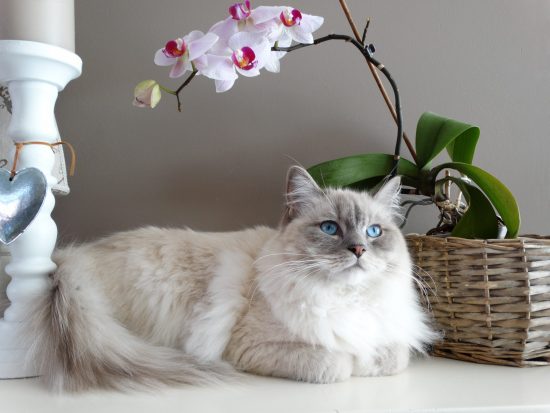
- Adult Weight: 10-14 pounds
- Height: 10-16 inches
- Lifespan: 12-15 years
- Physical Characteristics: Large, round paws; long, smooth fur; long tail; colors include brown, cream, red or white often with solid or lynx patterns
According to old legend, pure white cats resided in the Buddhist temples of the country of Burma or Myanmar, and were revered as the feline carriers of the souls of the priests who had departed the mortal plain. The Goddess of transmutation, better known as Tsim-Kyan-Kse, was worshiped in these temples, represented by a golden statue with glowing sapphire eyes. Mun-Ha served at the temple of Lao-Tsun and his companion Sinh, one of the 100 sacred white cats that lived at the temple, joined Mun-Ha for his evening prayers in front of the golden statue.
One day, the temple was raided for its riches and Mun-Ha was struck and injured. As Mun-Ha lay dying, Sinh put his paws on Mun-ha’s head and faced the statue of Tsim-Kyan-Kse. Then, Sinh’s white fur changed to a beautiful golden hue, his face, tail, and legs darkened to the color of the earth, and his eyes changed from yellow to a deep, sapphire blue.
Sinh’s paws, however, remained white as a symbol of Mun-Ha’s pure spirit. The next morning, all the temple cats had undergone the same transformation. Over the next seven days Sinh refused to eat and finally died, carrying Mun-Ha’s spirit into paradise.
This cat of mystery and legend, is a color pointed cat with long silky hair, blue eyes and four pure white feet.
Birmans are affectionate, gentle, and faithful companions with an air of dignity that seems to demand respect from their owners. As former temple cats, Birmans seem to have become accustomed to adoration and will greet visitors with curiosity rather than fear.
#4 Persian
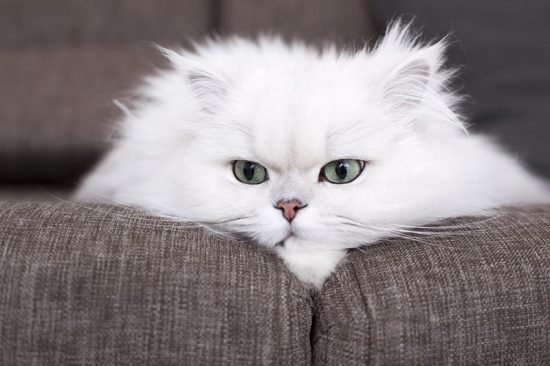
- Adult Weight: 10-13 pounds
- Height: 8-10 inches
- Lifespan: 10-17 years
- Physical Characteristics: Rounded face with a short muzzle; comes in a variety of colors including white, brown, and black; have a muscular body; large feet with long toes; hair is either very long or relatively short
Persians have been a favorite breed for over 125 years. These longhaired cats, including the ancestors of the modern Persian and Angora breeds, were first seen in Europe in the mid-to-late 1500s, and introduced by Roman and Phoenician caravans from Persia and Turkey. Researchers believe the recessive gene for long hair appeared spontaneously due to a mutation in the cat population in the cold mountainous areas of Persia.
Other travelers brought Persian and Angora cats into France and then into England, calling them “French cats” for many years. These cats also quickly became popular in Britain. During this time and for centuries after, the Turkish Angora and Persian varieties were often mixed.
At first, Angoras were preferred for their silky white coats but the British came to favor the stockier version. By 1871, distinct differences between the Persian and the Angora could be seen, the former being stockier with small, rounded ears, and the latter being slender and tall eared.
The Persian cat has large round eyes set wide apart in a large round head. Their long thick coat softens the lines of the cat and draws attention to the roundness in appearance.
Persians are great companions, if you prefer a placid and sweet-tempered cats.
#5 Savannah
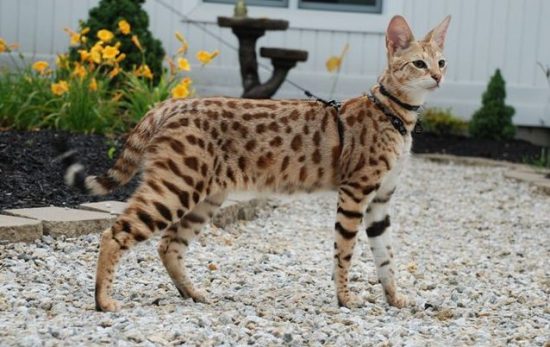
- Adult Weight: 12-25 pounds
- Height: 14-17 inches
- Lifespan: 12-20 years
- Physical Characteristics: The coat usually has a black spotted pattern; large, rounded, erect ears; extremely long legs; small head that is longer than it is wide; short tail with black rings; eyes have a hooded brow
The first Savannah was born in 1986 as the result of breeding an African serval and a domestic Siamese cat. A true cross is given the filial number F1. Subsequent generations are labeled F2, F3, and so on and most likely to be housecats. Members of the F1 and F2 generation are the largest, because of the strong influence of the serval genes.
The Savannah cat is densely muscular and leggy, with short spotted coats and large, cupped round ears.
Their energetic personalities and powerful bodies make them admirably athletic. Savannah cats can jump up to eight feet straight in the air and it is not unusual for them to splash in water, play fetch, and walk on a leash.
#6 Ragdoll
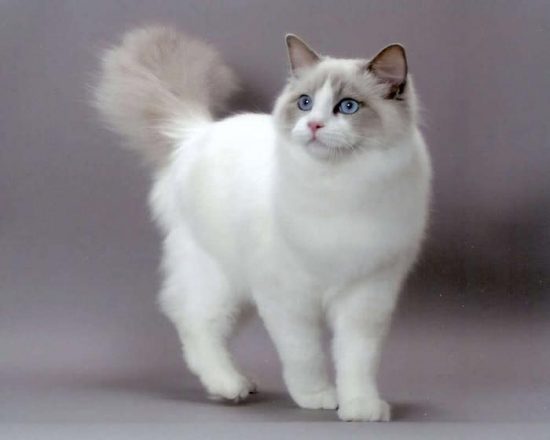
- Adult Weight: 10-15 pounds
- Height: 9-11 inches
- Lifespan: 15-19 years
- Physical Characteristics: Large head with a rounded muzzle; long, silky coat; comes in a variety of colors which include sealpoint and white, bluepoint and white, brown, cream, and tortoiseshell; muscular body; long tail; large, blue, wide-set eyes
The Ragdoll is a breed surrounded by mystery, controversy, and old fiction. The Ragdoll was developed in the 1960s by the late Ann Baker of Riverside, California. In fact, this is the only history of the breed that is not subject to debate. The foundation cat from which the breed originated, was a semi-feral longhaired white female of unknown parentage.
Despite Ann Baker’s colorful stories, it’s likely that the foundation cat possessed some exceptional genes, either recessive or masked by her dominant white color, allowing for some striking offspring. In particular a mitted sealpoint longhaired male, with a white blaze and a white tail tip named Daddy Warbucks, became the foundation of the Ragdoll breed. In 1971, Ann Baker trademarked the name Ragdoll, after years of selective breeding.
The Ragdoll’s hard-won CFA championship status was granted in February 2000, and the breed was finally recognized for championship by every major North American cat association.
The Ragdoll is an affectionate and intelligent cat, with graceful movement and subdued power. They are impervious to pain regardless of the stories surrounding the breed. If you accidentally step on their tails, they will react the same as any other cat will.
#7 Ragamuffin
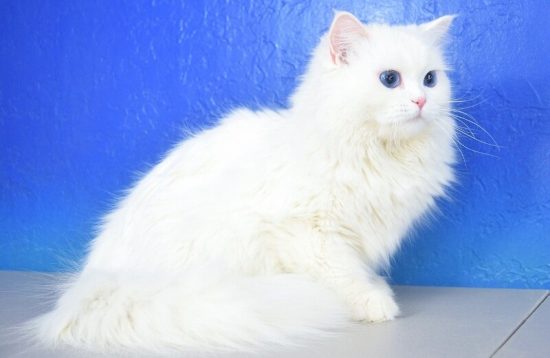
- Adult Weight: 10-15 pounds
- Height: 10-12 inches
- Lifespan: 12-18 years
- Physical Characteristics: Large, muscular body; short neck; fatty pad on belly; thick, bushy coat with colors that are blue, brown tabby with white, tortoiseshell and mink
The RagaMuffin is not a new breed and is as old as the better-known Ragdoll. The history of the RagaMuffin is intertwined with the history of the Ragdoll cat.
The first cat of this breed, Josephine, was a semi-feral solid white Turkish Angora-type cat that resided in Riverside, California. One of her kittens went on to become one of the foundation males of this breed. The cats that had the pointed pattern and mitted feet were called Cherubim, but others came in a variety of solid and bi-color patterns. The non-pointed and non-mitted cats were called Miracle Ragdolls.
In 1975, some individuals split from the founder’s Ragdoll association, naming their new breed RagaMuffin. The RagaMuffin was represented as a new breed, not as a new Ragdoll color division, and therefore had to go through each phase of acceptance and meet each association’s requirements as a new breed. Today all associations except CCA recognize the RagaMuffin, although TICA ( The International Cat Association) has yet to accept the breed beyond registration status.
The RagaMuffin is similar, but not identical, to the Ragdoll because of many years of separation between the two breeds. The RagaMuffin comes in a wider variety of colors, and the body type is a little different.
The Ragamuffin cat is known for its large size, large expressive eyes, and docile nature. RagaMuffins do not attain full maturity until approximately four years of age.
#8 Norwegian Forest Cat
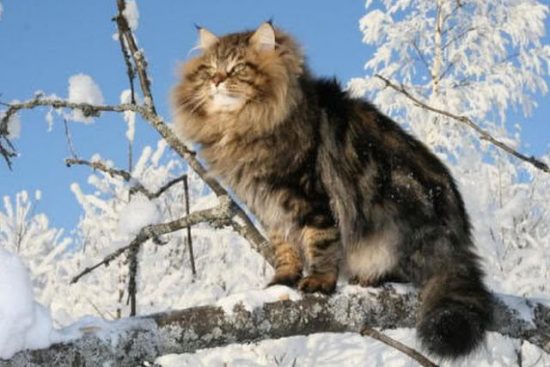
- Adult Weight: 10-20 pounds
- Height: 9-12 inches
- Lifespan: 14-16 years
- Physical Characteristics: Colors can vary and every color and pattern is possible; have a unique double coat that includes a dense undercoat and a long, silky smooth overcoat; bushy tail that is broader at the base; muscular and solid body; large, almond shaped, slightly angled eyes
The Norwegian Forest Cat, is a natural breed and despite a feral appearance is not a descendant or a hybrid of any wild cat species. Forest Cats probably arrived in Norway from Europe, and are the descendants of domestic cats introduced to northern Europe by the Romans.
It is supposed that the Norwegian Forest Cat has existed for a long time, due to several depictions of large, longhaired cats in Norse mythology. However, estimates of when these cat tales were written vary vastly.
Most Norse myths were passed down by oral tradition and were finally recorded in what was called the Edda poems, written sometime between 800 c.e. and 1200 c.e. These myths suggest that domestic cats have been in Norway for hundreds, possibly thousands, of years and whether the cats portrayed in the myths are Forest Cats is subject to debate.
The Norwegian Forest Cat does have unusually strong claws and can climb trees and rocks with ease.
Known as the strong, silent type, the Norwegian Forest Cat is a great at purring, especially when perched beside their favorite human. They tend not to bond with one person, but rather love everyone equally, unconditionally and enthusiastically.
#9 Chausie
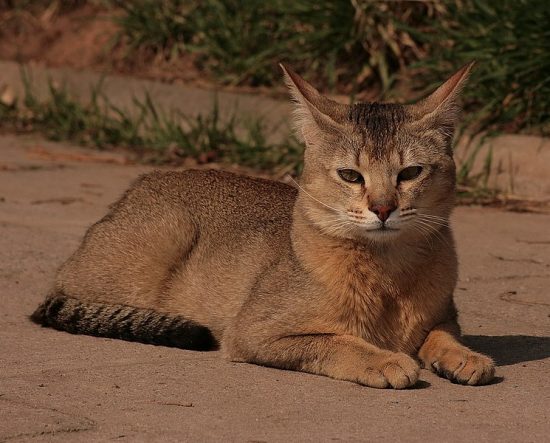
- Adult Weight: 11-16 pounds
- Height: 14-18 inches
- Lifespan: 12-16 years
- Physical Characteristics: Have a tall, slender body; elongated snout; large ears; commonly black or brown with a tabby pattern
The first hybrids of the jungle cat and the domestic cat may have been born in Egypt several thousand years ago. The jungle cat is native to a region spanning Southeast Asia, India, and the Middle East.
It is also known that the ancient Egyptians kept domestic cats as pets. Because domestic cats are likely to have frequently encountered jungle cats along the Nile and occasionally even within their owners homes, it seems that hybrids of the two species were probably often born.
The Chausie is a lanky, muscular cat with exceptionally long legs. Their long, powerful bodies are contrasted by a prominent short tail. Their coats are typically a tawny agouti, although some Chausies have a black or grizzled black coat.
The Chausie’s personality is active, intelligent, sociable, and they are best suited to experienced, ardent owners who can handle an energetic and headstrong feline.
#10 Siberian
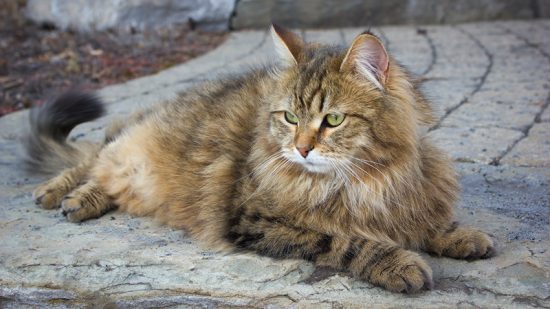
- Adult Weight: 10-25 pounds
- Height: 9-13 inches
- Lifespan: 10-15 years
- Physical Characteristics: Muscular body; come in all color combinations, especially white; long, thick overcoat with a tight undercoat; relatively short muzzle with rounded features; large, round eyes
Longhaired Russian cats have been around for hundreds of years. When and how these longhaired cats made their way to Siberia is unknown, but it is speculated that the breed arrived with Russian emigrants.
According to some Siberian fanciers, Russians immigrating to Siberia brought their cats with them. The mutation for long hair may have occurred in three separate areas, Russia, Persia, and Asia Minor.
However, it’s possible that the longhair mutation occurred in Russia and spread from Russia into Turkey, crossbreeding with local cats to become the Angora, and into Persia, crossbreeding with local cats to become the Persian. If this is true then all longhairs are derived from the Russian Longhair.
The Siberian is a medium to large size cat with a strong triple-coat and surprising heft for its size. Their overall appearance shows strength, and alertness, with a sweet facial expression. The breed is extremely slow to mature and can take as long as 5 years.
Siberians are affectionate cats that are known to be playful and protective. Siberians have a fascination with water, and may drop toys into their water dish or investigate sinks and tubs when wet.

